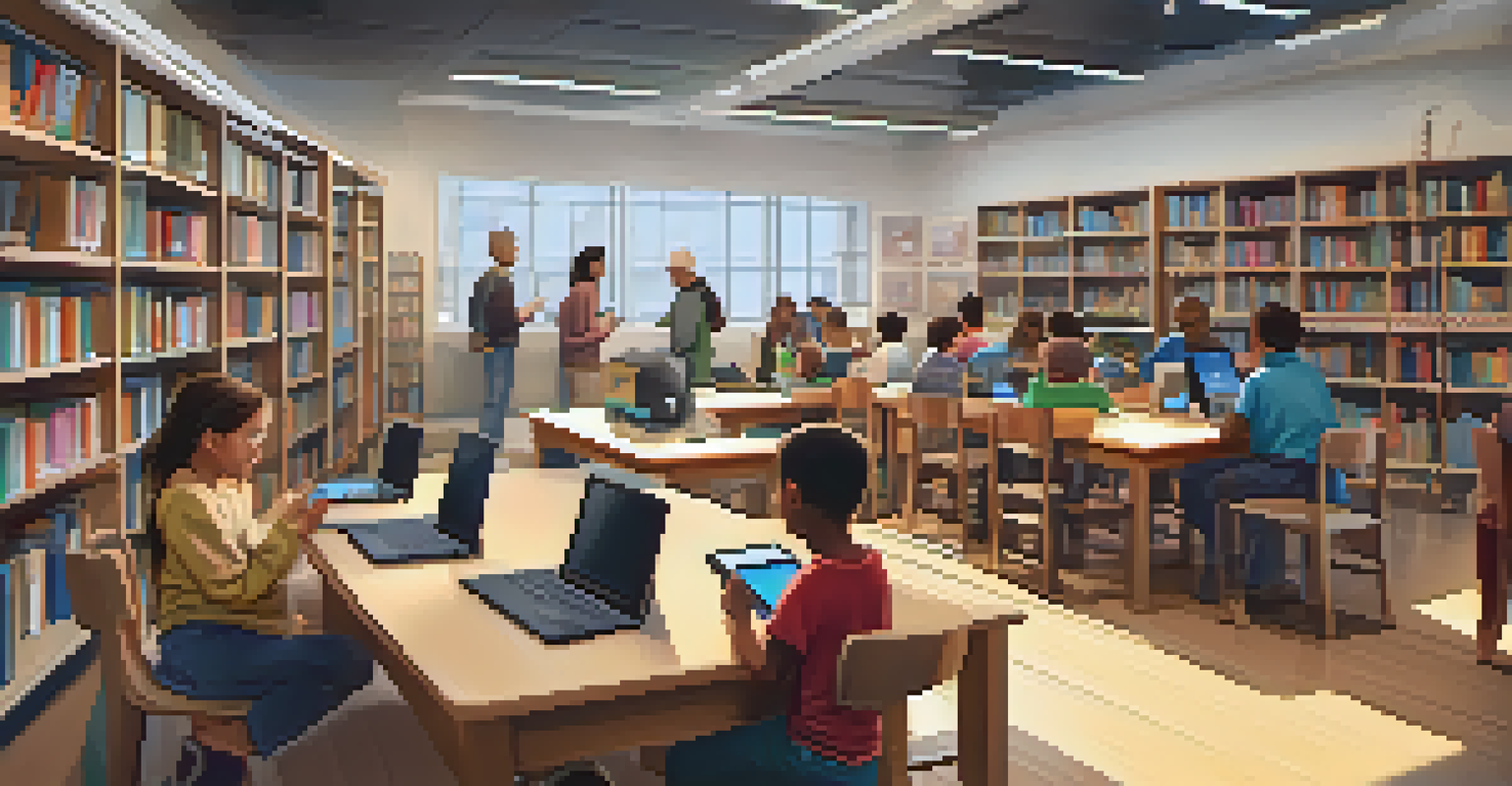Access to Digital Tools: A Right for Every Student

Understanding Digital Access in Education
In today’s world, digital access is as essential as textbooks were in the past. It’s not just about having a device; it’s about being able to connect to a wealth of information and resources online. Digital tools can enhance learning experiences and provide opportunities for collaboration and creativity, making education more engaging and effective.
Access to technology is a fundamental human right, and we must ensure that every student has the tools they need to succeed in the digital age.
However, many students still lack access to these vital tools, which can create a significant gap in educational equity. Imagine trying to learn without a reliable internet connection or access to a computer at home. This situation can leave students feeling isolated and hinder their ability to keep up with peers who have the necessary resources.
Thus, ensuring that every student has access to digital tools is not merely a convenience; it’s a right that supports their educational journey and future success. By prioritizing equitable access, we can help level the playing field and foster a more inclusive learning environment.
The Impact of Digital Tools on Learning
Digital tools have transformed how students learn, offering interactive platforms that cater to various learning styles. For instance, educational apps can make math fun through engaging games, while online forums allow students to collaborate on projects regardless of their physical location. These tools not only enhance understanding but also encourage critical thinking and problem-solving skills.

Additionally, access to digital resources means students can explore subjects in-depth, utilizing online libraries and courses that expand their knowledge far beyond the classroom. This kind of exploration fosters a love for learning and encourages lifelong curiosity, which is vital in today’s fast-paced world.
Digital Access is Essential for Equity
Ensuring every student has access to digital tools is a fundamental right that supports educational equity and future success.
When students have access to these tools, they become empowered learners, taking charge of their education and developing skills that will serve them well in the future. In short, digital access is a gateway to a richer, more meaningful educational experience.
Digital Divide: A Growing Concern
Despite the benefits, the digital divide remains a pressing issue, with many students, especially in underprivileged areas, struggling to access technology. This gap not only affects academic performance but also hampers social development and technological fluency. Without proper access, students miss out on essential skills that are increasingly required in the workforce.
In a world where knowledge is power, access to education and technology must be a priority for all.
Consider the impact of remote learning during the COVID-19 pandemic. Students without internet access faced overwhelming challenges, falling behind their peers who could seamlessly transition to online education. This situation highlighted the urgent need for solutions to bridge the digital divide and ensure that all students have the tools they need for success.
Addressing this divide requires concerted efforts from schools, communities, and policymakers. By investing in infrastructure and providing resources, we can help create an equitable educational landscape that supports every student’s growth.
Role of Schools in Providing Digital Access
Schools play a pivotal role in ensuring students have access to digital tools. By integrating technology into the curriculum, they can teach students how to navigate and use these tools effectively. Moreover, schools can offer resources like lending programs for devices, ensuring that no student is left behind due to lack of equipment.
Additionally, professional development for teachers is crucial, enabling them to utilize digital tools in ways that enhance learning. When educators are well-equipped to incorporate technology, students benefit from a more dynamic and engaging learning environment. This collaboration helps students harness the power of technology while fostering critical digital skills.
Bridging the Digital Divide
The digital divide remains a significant concern, particularly for students in underprivileged areas, impacting their academic and social development.
Ultimately, schools must view digital access as a fundamental part of their mission. By prioritizing this access, they can create a supportive and inclusive atmosphere that champions every student’s potential.
Community Partnerships for Digital Equity
Collaboration with local organizations can significantly enhance digital access for students. Libraries, nonprofits, and businesses can partner with schools to provide necessary technology and training. For example, a local library might offer free workshops on digital literacy, empowering students to make the most of the tools available to them.
These partnerships can also help bridge the gap in resources by providing internet access in community spaces. By creating safe, inclusive environments where students can study and learn, communities can foster a culture of support and encouragement. This collaboration not only benefits students but also strengthens community ties.
In essence, community involvement is vital in creating a robust support system for students. By working together, we can ensure that every student has the opportunity to thrive in a digital-first world.
Policy Changes Needed for Digital Access
To achieve equitable access to digital tools, policy changes are essential. Governments and educational bodies must prioritize funding for technology in schools, especially in underserved areas. This funding can help provide devices, internet access, and ongoing training for both students and teachers.
Furthermore, policies should focus on creating sustainable programs that ensure long-term access rather than one-time solutions. For instance, initiatives that encourage schools to partner with tech companies can lead to ongoing support for maintaining and upgrading technology resources.
Community and Policy Collaboration
Effective partnerships and policy changes are crucial for providing sustainable digital access to all students, fostering an inclusive educational environment.
Ultimately, effective policies can create a foundational change in how schools approach digital access, ensuring that every student, regardless of their background, has the necessary tools to succeed.
A Vision for an Inclusive Digital Future
As we look ahead, the goal is to create an education system where digital access is a given for every student. This vision involves not just providing devices but also embedding technology into the learning experience in meaningful ways. Imagine a future where all students can seamlessly engage with digital tools, fostering creativity and collaboration.
To reach this goal, ongoing dialogue among educators, policymakers, and communities is vital. By sharing insights and best practices, we can collectively address challenges and celebrate successes in bridging the digital divide. This collaborative spirit can serve as a catalyst for innovative solutions that empower students.

In conclusion, ensuring access to digital tools is a shared responsibility that can transform education for all. Together, we can create a more equitable future where every student has the opportunity to thrive in a digital world.